Sustainability Evaluation of the Stormwater Drainage System in Six Indian Cities
Abstract
:1. Introduction
2. Materials and Methods
2.1. Description of Cities
2.2. Selection of Indices for the Study
2.3. Data Availability
- Landsat 7 OLI satellite image analysis employing 1 to 7 bands in ArcGIS 10.4.
- Landsat 8 OLI satellite image analysis employing 1 to 7 bands in ArcGIS 10.4.
- Shuttle Radar Topographic Mission (SRTM) 30 m resolution Digital Elevation Model (DEM).
- Rainfall data for the period from 1991 to 2019 observed using the self-recording Rain Gauge (SRRG) at the Department of Hydrology, IIT Roorkee for Roorkee site and IMD 0.25 degree grided data as secondary data for other sites.
- Population data derived from past census records.
- Physio-chemical parameters of stormwater as analysed for Roorkee and collected through various research and reports for other sites as secondary data.
2.4. Processing of Data
2.5. Enumeration of Individual Indices in Standalone Mode
2.5.1. Natural Drainage System Index
2.5.2. Drainage Coverage Index
2.5.3. Permeability Index
2.5.4. Water Body Rejuvenation Index
2.5.5. Water Logging Index
2.5.6. Area Vulnerability Index
2.5.7. Water Body Vulnerability Index
2.5.8. People Vulnerability Index
2.5.9. Stormwater Discharge Quality Index
2.5.10. Flood Moderation Index
2.5.11. Rainfall Intensity Index
2.6. Analytical Hierarchy Process (AHP): Concept and Role in the Study for Estimation of Weight Coefficients
2.7. Process of Aggregation of Indices
3. Results and Discussions
3.1. Sustainability Indices in a Standalone Mode
3.2. Aggregated Overall System Sustainability Index
4. Conclusions
- (a)
- The key indices proposed by the Government of India’s sub-committee for the development of “National sustainable habitat parameters on urban stormwater management” were observed to be quite valuable in the assessment of sustainability of the stormwater drainage systems.
- (b)
- For the indices enumerated in a standalone mode, among the Tier I cities, none of the values of the indices fell within the permissible range, although some values were close to the minimum admissible values. These cities apparently face significant challenges primarily in terms of natural drainage, permeability, water logging, flood moderation, and rainfall intensity. On the other hand, the Tier II cities exhibited marginally better results, displayed by better compliance in several indices. Chandigarh stood out as a city with notably better performance across most indices.
- (c)
- The enumeration results of an overall sustainability index showed that among all the Tier I and II cities, Chandigarh again displayed the most sustainable drainage system (0.761), whereas all other cities, namely Varanasi (0.491) and Roorkee (0.483) in the Tier I category and Mumbai (0.540), Delhi (0.534), and Chennai (0.516) in the Tier II category, displayed quite low values, around the halfway mark in the sustainability index range.
- (d)
- The results undoubtedly established Chandigarh as the most accomplished city in this regard as per both enumeration modes, superior to other cities in most respects. Regarding the other cities, it should be noted that direct comparison between the two modes may not be practically attainable. This may be due to the fact that the weight coefficients estimated through the AHP process are unique for every city, giving due regard to its specific attributes, whose interplay with the city-specific data could influence the final outcome.
- (e)
- Poor stormwater discharge quality exceeded the desired limit in all cities. This truly highlighted the critical need for initiating stormwater treatment (unlike sewage treatment, which is practiced already) and further strengthening pollution control measures for non-point sources in urban areas, which are greatly lacking at present.
- (f)
- The findings could be corroborated by the ground realities observed in these cities in general.
Author Contributions
Funding
Institutional Review Board Statement
Informed Consent Statement
Data Availability Statement
Conflicts of Interest
References
- Ress, L.D.; Ling, C.; Hung, J.; James, L. A Impacts of urban drainage systems on stormwater hydrology: Rocky Branch Watershed, Columbia, South Carolina. J. Flood Risk Manag. 2020, 13, e12643. [Google Scholar] [CrossRef]
- Teshome, M.; Devi, A.R. A Review of Recent Studies on Urban Stormwater Drainage System for Urban Flood Management. Preprints 2020, 2020100295. [Google Scholar] [CrossRef]
- Sharma, D. Sustainable Drainage System (SuDS) for Stormwater Management: A Technological and Policy Intervention to Combat Diffuse Pollution. In Proceedings of the 11th International Conference on Urban Drainage, Edinburgh, Scotland, UK, 31 August–5 September 2008. [Google Scholar]
- Benzerra, A.; Cherrared, M.; Bernard, C.; Frederic, C.; Zekiouk, T. Decision support for sustainable urban drainage system management: A case study of Jijel, Algeria. J. Environ. Manag. 2012, 101, 46–53. [Google Scholar] [CrossRef] [PubMed]
- Andimuthu, R.; Kandasamy, P.; Mudgal, B.V.; Jeganathan, A.; Balu, A.; Sankar, G. Performance of urban storm drainage network under changing climate scenarios: Flood mitigation in Indian coastal city. Sci. Rep. 2019, 9, 7783. [Google Scholar] [CrossRef]
- UNDESA. U.N. World Urbanization Prospects: The 2014 Revision-Highlights; United Nations: New York, NY, USA, 2014. [Google Scholar] [CrossRef]
- Emama, W.; Edae, H.; Abdisa, T.; Hirko, D. Performance Assessment of Storm Water Drainage System by Stormwater Management Model. Preprints 2022. [Google Scholar] [CrossRef]
- UNDESA. World Urbanization Prospects: The 2011 Revision; United Nations, Department of Economic and Social Affairs (DESA), Population Division, Population Estimates and Projections Section: New York, NY, USA, 2012. [Google Scholar] [CrossRef]
- Masaki, Y.; Hanasaki, N.; Takahashi, K.; Hijioka, Y. Global-scale analysis on future changes in flow regimes using Gini and Lorenz asymmetry coefficients. Water Resour. Res. 2014, 50, 4054–4078. [Google Scholar] [CrossRef]
- Kourtis, I.M.; Tsihrintzis, V.A. Adaptation of urban drainage networks to climate change: A review. Sci. Total Environ. 2021, 771, 145431. [Google Scholar] [CrossRef]
- Lashford, C. Sustainable Drainage Management Train: A Sustainable Flood Management Strategy; Coventry University: Coventry, UK, 2012. [Google Scholar]
- Gimenez-Maranges, M.; Breuste, J.; Hof, A. Sustainable Drainage Systems for transitioning to sustainable urban flood management in the European Union: A review. J. Clean. Prod. 2020, 255, 120191. [Google Scholar] [CrossRef]
- Zahmatkesh, Z.; Karamouz, M.; Goharian, E.; Burian, S.J. Analysis of the Effects of Climate Change on Urban Stormwater Runoff Using Statistically Downscaled Precipitation Data a Change Factor Approach. J. Hydrol. Eng. 2018, 20, 05014022. [Google Scholar] [CrossRef]
- Peterson, E.W.; Wicks, C.M. Assessing the importance of conduit geometry and physical parameters in karst systems using the stormwater management model (SWMM). J. Hydrol. 2006, 329, 294–305. [Google Scholar] [CrossRef]
- Cuppens, A.; Smets, I.; Wyseure, G. Identifying sustainable rehabilitation strategies for urban waste water system: A retrospective and interdisciplinary approach. Case study of Coronel Oviedo, Paraguay. J. Environ. Manag. 2013, 114, 423–432. [Google Scholar] [CrossRef] [PubMed]
- Murty, R.K.; Gupta, H.R.; Dikshit, S.K. An overview of sustainability assessment methodologies. Ecol. Indices 2012, 15, 281–299. [Google Scholar] [CrossRef]
- Phil Jones, P.; Macdonald, N. Making space for unruly water: Sustainable drainage systems and the disciplining of surface runoff. Geoforum 2007, 38, 534–544. [Google Scholar] [CrossRef]
- Swathi, V.; Srinivasa Raju, K.; Singh, A. Application of Stormwater Management Model to an Urban Catchment. Hydrol. Model. 2018, 81, 175–184. [Google Scholar]
- Sirishantha, U.; Rathnayake, U. Sustainable urban drainage systems (SUDS)—What it is and where do we stand today? Eng. Appl. Sci. Res. 2017, 44, 235–241. [Google Scholar]
- de Almeida, G.A.M.; Bates, P.; Ozdemir, H. Modelling urban floods at submetre resolution: Challenges or opportunities for flood risk management? J. Flood Risk Manag. 2018, 11, S855–S865. [Google Scholar] [CrossRef]
- Droogers, P.; Soet, M.; van Schaik, H.; Witmer, M. Integrating Climate Change Adaptation into Development Co-operation for the Water Sector Table of Contents. Future Water 2010, 1–31. [Google Scholar]
- Census of India. 2011. Available online: http://censusindia.gov.in/2011census/hlo/hlo_highlights.html?drpQuick=anddrpQuickSelect=andq=Census+Drainage+facilities+in+households (accessed on 13 July 2023).
- Roy, C.; Sati, V.P.; Biswas, A.; Kumar, S. Status of drinking water, sanitation facilities, and hygiene in West Bengal: Evidence from the National Family Health Survey of India (NFHS), 2019–2021. J. Water Sanit. Hyg. Dev. 2023, 13, 51. [Google Scholar] [CrossRef]
- Kyi, P.M.; Zin, W.W.; Kyi, C.C.T.; Maung, T. Study on Storm Water Drainage System of Kyeemyindaing Township; Department of Civil Engineering, Yangon Technological University: Yangon, Myanmar, 2017. [Google Scholar]
- Singh, O.; Kumar, M. Flood occurrences, damages, and management challenges in India: A geographical perspective. Arab. J. Geosci. 2017, 10, 102. [Google Scholar] [CrossRef]
- Sala, S.; Ciuffo, B.; Nijkamp, P. A systemic framework for sustainability assessment. Ecol. Econ. 2015, 119, 314–325. [Google Scholar] [CrossRef]
- CPHEEO. National Mission on Sustainable Habitat: Adaptation and Mitigation Measures In the Field of Water Supply & Sanitation. 2014. Available online: https://smartnet.niua.org/content/91c0bcdf-4ce8-41ac-9a11-34e72f6b74ae (accessed on 13 July 2023).
- Report of Sub-Committee for Development of ‘National Sustainable Habitat Parameters on Urban Stormwater Management’. 2010. Available online: https://www.mohua.gov.in/upload/uploadfiles/files/uswm.pdf (accessed on 13 July 2023).
- Das, R.K. Sustainable Urban Drainage Systems (SUDS)—Is It the Answer to the Problem of Urban Flash Floods in New Delhi, India. 2012. Available online: https://www.researchgate.net/publication/228327252_Sustainable_Urban_Drainage_Systems_-_A_possible_solution_to_the_problems_of_Flash_Floods_in_New_Delhi_India (accessed on 13 July 2023).
- Delhi Development Authority. Master Plan for Delhi, 2021; Development Authority, Government of National Capital Territory of Delhi, Government of India: New Delhi, India, 2005.
- Pareva, M. Urban flooding and its management. In Proceedings of the First Disaster Management Congress, New Delhi, India, 29–30 November 2006. [Google Scholar]
- Gupta, K. Urban flood resilience planning and management and lessons for the future: A case study of Mumbai, India. Urban Water J. 2007, 4, 183–194. [Google Scholar] [CrossRef]
- Sansare, D.A.; Mhaske, S.Y. Storm water Management of Mumbai city by using Pervious Concrete on GIS based platform. Int. J. Recent Technol. Eng. (IJRTE) 2019, 8, 4400–4406. [Google Scholar] [CrossRef]
- Singh, N.K.; Nathawat, M.S. Quantifying the characteristics and types of urban growth of Varanasi city using multi-temporal remotely sensed data and geospatial techniques. Transactions 2023, 45, 27–40. [Google Scholar]
- Prudhvi Raju, K.N.; Pandey, M.K.; Sarkar, S. A note on boundaries in atlas maps. J. Geol. Soc. India 2014, 83, 563–566. [Google Scholar] [CrossRef]
- Mishra, M.; Dugesar, V.; Prudhvi Raju, K.N. Flood Risk and Impact Analysis of Varanasi City Region, India. J. Sci. Res. 2022, 66, 22–32. [Google Scholar] [CrossRef]
- Yusoff, Y.M. Kinematic Wave Modeling of a Semi-Urban Watershed. Master’s Dissertation, Department of Hydrology, IIT Roorkee, Roorkee, India, 1991. [Google Scholar]
- Singhal, D.C.; Roy, T.N.; Joshi, H.; Seth, A.K. Imapact os sewage irrigation on groundwater quality of Roorkee town, Uttaranchal. Hydrol. J. 2001, 24, 1–15. [Google Scholar]
- Arya, D.S.; Joshi, H.; Abbasi, S.A. Developmental trends and their environmental impact in a typical central Indian town with special reference to Roorkee. Environ. Monit. Assess. 1994, 33, 135–150. [Google Scholar] [CrossRef] [PubMed]
- Jarvis, A.; Reuter, H.I.; Nelson, A.; Guevara, E. Hole-Filled Seamless SRTM Data V4. International Centre for Tropical Agriculture (CIAT). 2008. Available online: http://srtm.csi.cgiar.org (accessed on 13 July 2023).
- ASCE; WEF. Design and Construction of Urban Storm Water Management Systems, American Society of Civil Engineers Manuals and Reports of Engineering Practice no. 77 and Water Environment Federation Manual of Practice FD-20. 1992. Available online: https://www.google.com.hk/url?sa=t&rct=j&q=&esrc=s&source=web&cd=&cad=rja&uact=8&ved=2ahUKEwj1l6HgyfmBAxXehlYBHaEdDVEQFnoECAkQAQ&url=https%3A%2F%2Fascelibrary.org%2Fdoi%2Fpdf%2F10.1061%2F9780872628557.fm&usg=AOvVaw2n1pmC7noMkrUNcRadubSC&opi=89978449 (accessed on 13 July 2023).
- Linsley, R.K., Jr.; Kohler, M.A.; Paulhus, J.L.H. Hydrology for Engineers, 3rd ed.; Chapters 3 and 4; McGraw-Hill: New York, NY, USA, 1982. [Google Scholar]
- Pazwah, H. Urban Stormwater Management; Taylor and Francis Group: Abingdon, UK, 2011; ISBN 978-1-4398-1035-4. [Google Scholar]
- Ramachandran, A.; Palanivelu, K.; Mudgal, B.V.; Jeganathan, A.; Guganesh, S.; Abinaya, B.; Elangovan, A. Climate change impact on fluvial flooding in the Indian sub-basin: A case study on the Adyar sub-basin. PLoS ONE 2019, 14, e0216461. [Google Scholar] [CrossRef] [PubMed]
- Kellagher, R. Preliminary Rainfall Runoff Management for Developments. R&D Technical Report, 2012. W5-074/A/TR/1, Revision E. 2012. Available online: https://eprints.hrwallingford.com/549/ (accessed on 13 July 2023).
- Luo, P.; Apip, H.B.; Duan, W.; Takara, K.; Nover, D. Impact assessment of 21 rainfall scenarios and land use change on hydrologic response using synthetic Area IDF 22 curves. J. Flood Risk Manag. 2015, 11, S84–S97. [Google Scholar] [CrossRef]
- De Paola, F.; Giugni, M.; Topa, M.E.; Bucchignani, E. Intensity-Duration-Frequency (IDF) rainfall curves, for data series and climate projection in African cities. SpringerPlus 2014, 3, 133. [Google Scholar] [CrossRef]
- Josephine, V.; Mudgal, B.V.; Thampi, S. Applicability of Doppler weather radar based rainfall data for runoff estimation in Indian watersheds—A case study of Chennai basin. Sadhana 2014, 39, 989–997. [Google Scholar] [CrossRef]
- Kordana, S.; Slys, D. Decision Criteria for the Development of Stormwater Management Systems in Poland. Resources 2020, 9, 20. [Google Scholar] [CrossRef]
- Saaty, T. The Analytic Hierarchy Process, 1st ed.; McGraw-Hill: New York, NY, USA, 1980. [Google Scholar]
- Giner-Santonja, G.; Calvo, V.V.; Lepe, G.R. Application of AHP and corrective factors for the determination of best available techniques and emission limit values at installation level: A case study in four cement installations. Sci. Total Environ. 2019, 660, 834–840. [Google Scholar] [CrossRef] [PubMed]
- Ghimire, L.P.; Kim, Y. An analysis on barriers to renewable energy development in the context of Nepal using AHP. Renew. Energy 2018, 129, 446–456. [Google Scholar] [CrossRef]
- Wang, Y.; Xu, L.; Solangi, Y.A. Strategic renewable energy resources selection for Pakistan: Based on SWOT-Fuzzy AHP approach. Sustain. Cities Soc. 2020, 52, 101861. [Google Scholar] [CrossRef]
- Lu, Y.; Xu, H.; Wang, Y.; Yang, Y. Evaluation of water environmental carrying capacity of city in Huaihe River Basin based on the AHP method: A case in Huai’an City. Water Resour. Ind. 2017, 18, 71–77. [Google Scholar] [CrossRef]
- Liu, Y.; Wang, C.; Chun, Y.; Yang, L.; Chen, W.; Ding, J. A Novel Method in Surface Water Quality Assessment Based on Improved Variable Fuzzy Set Pair Analysis. Int. J. Environ. Res. Public Health 2019, 16, 4314. [Google Scholar] [CrossRef]
- Mannina, G.; Rebouças, T.F.; Cosenza, A.; Sànchez-Marrè, M.; Gibert, K. Decision support systems (DSS) for wastewater treatment plants—A review of the state of the art. Bioresour. Technol. 2019, 290, 121814. [Google Scholar] [CrossRef]
- Leal, J.E. AHP-express: A simplified version of the analytical hierarchy process method. MethodsX 2019, 7, 100748. [Google Scholar] [CrossRef]
- Saaty, T. Decision making—The Analytic Hierarchy and Network Processes (AHP/ANP). J. Syst. Sci. Syst. Eng. 2004, 13, 1–35. [Google Scholar] [CrossRef]
- Ott, W. Environmental Indices: Theory and Practice; Ann Arbor Science Publishers: Ann Arbor, MI, USA, 1978. [Google Scholar]

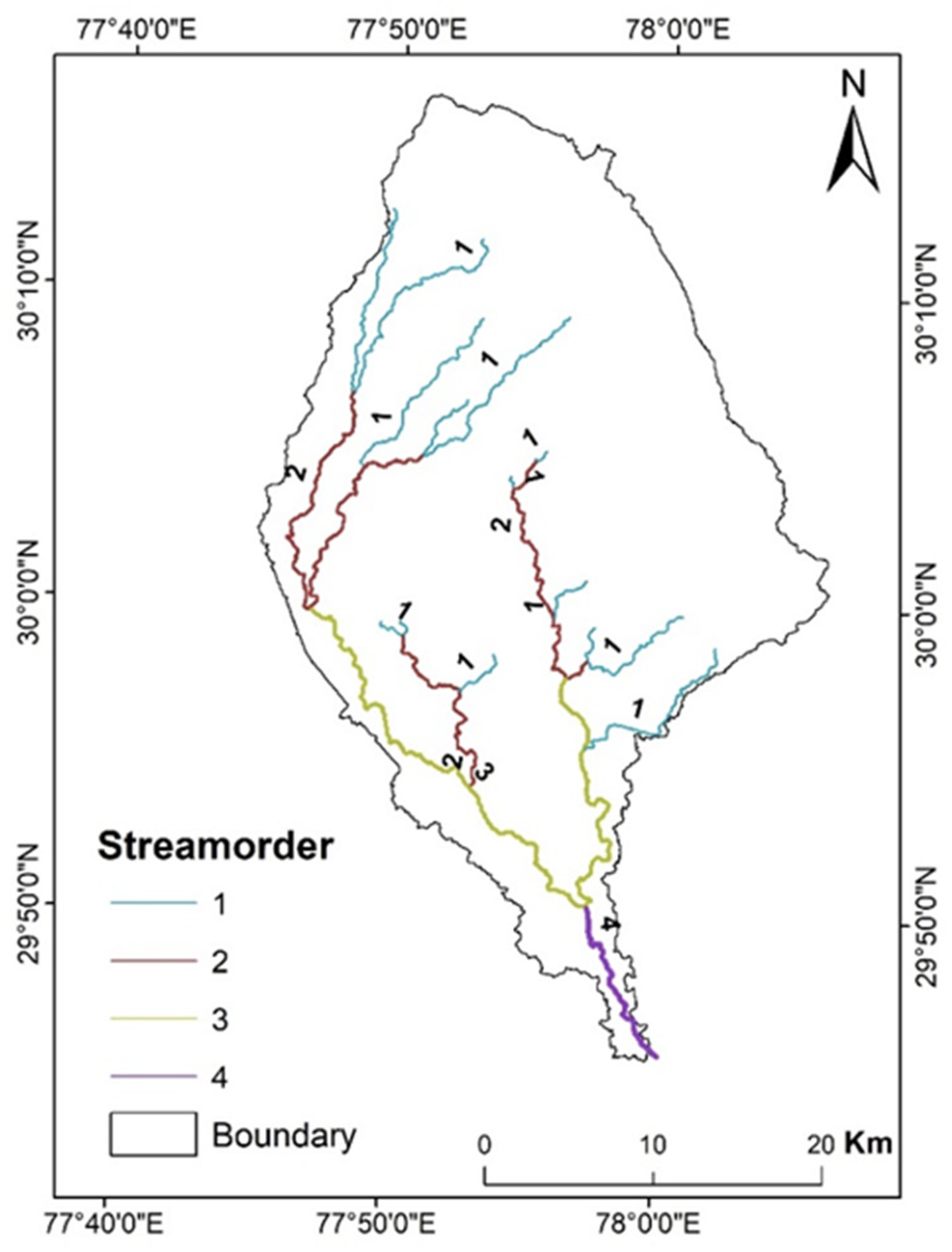

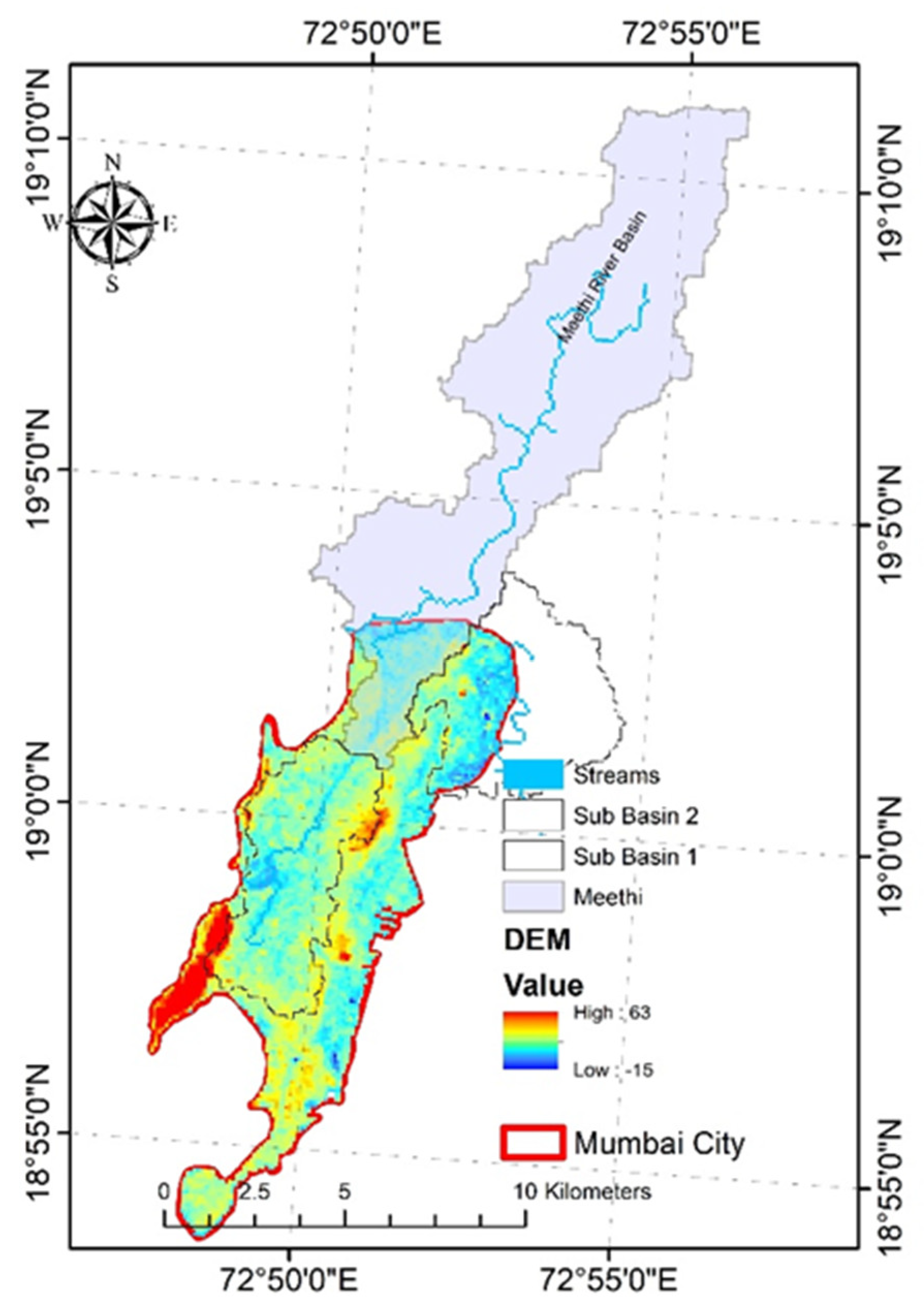
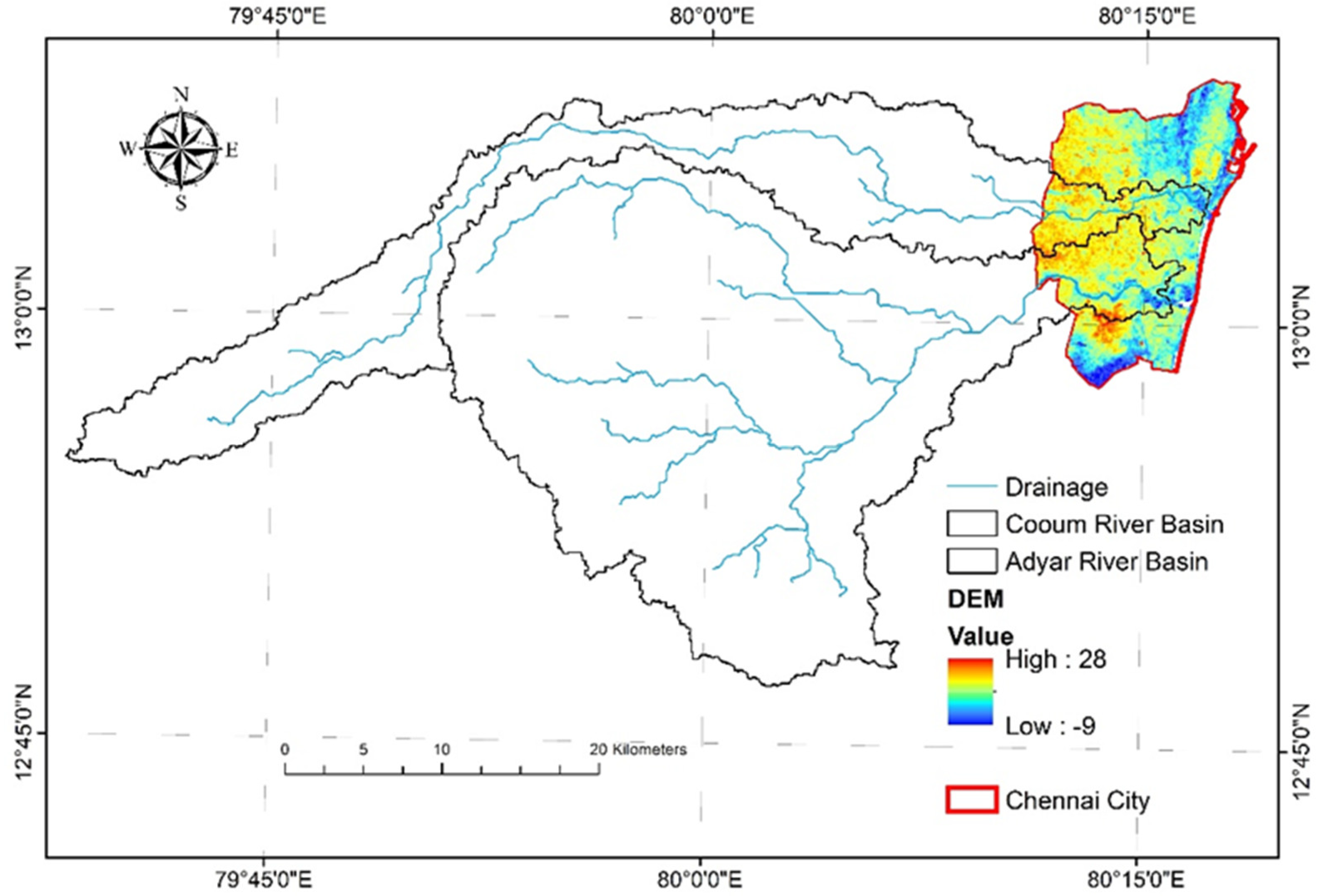
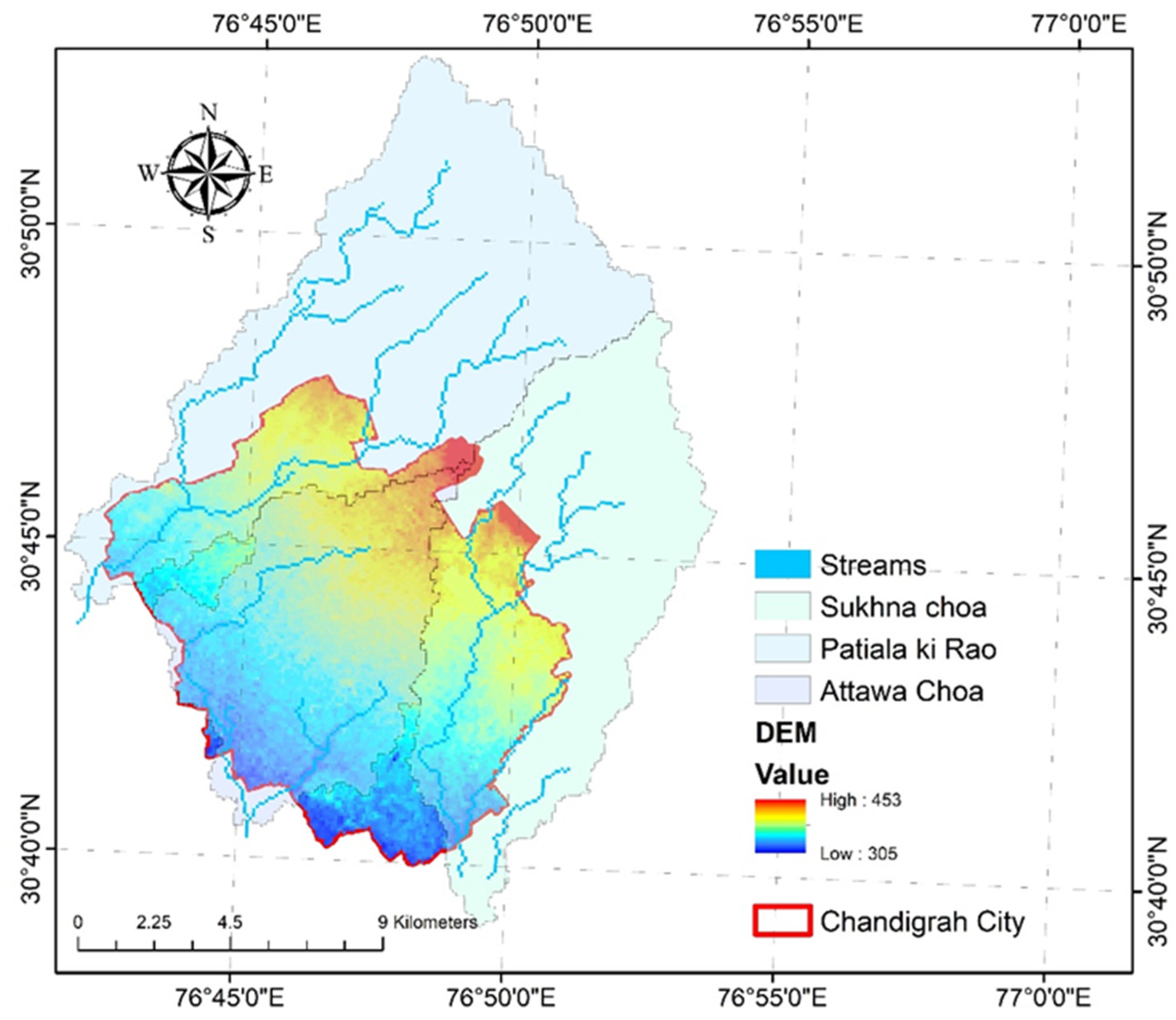
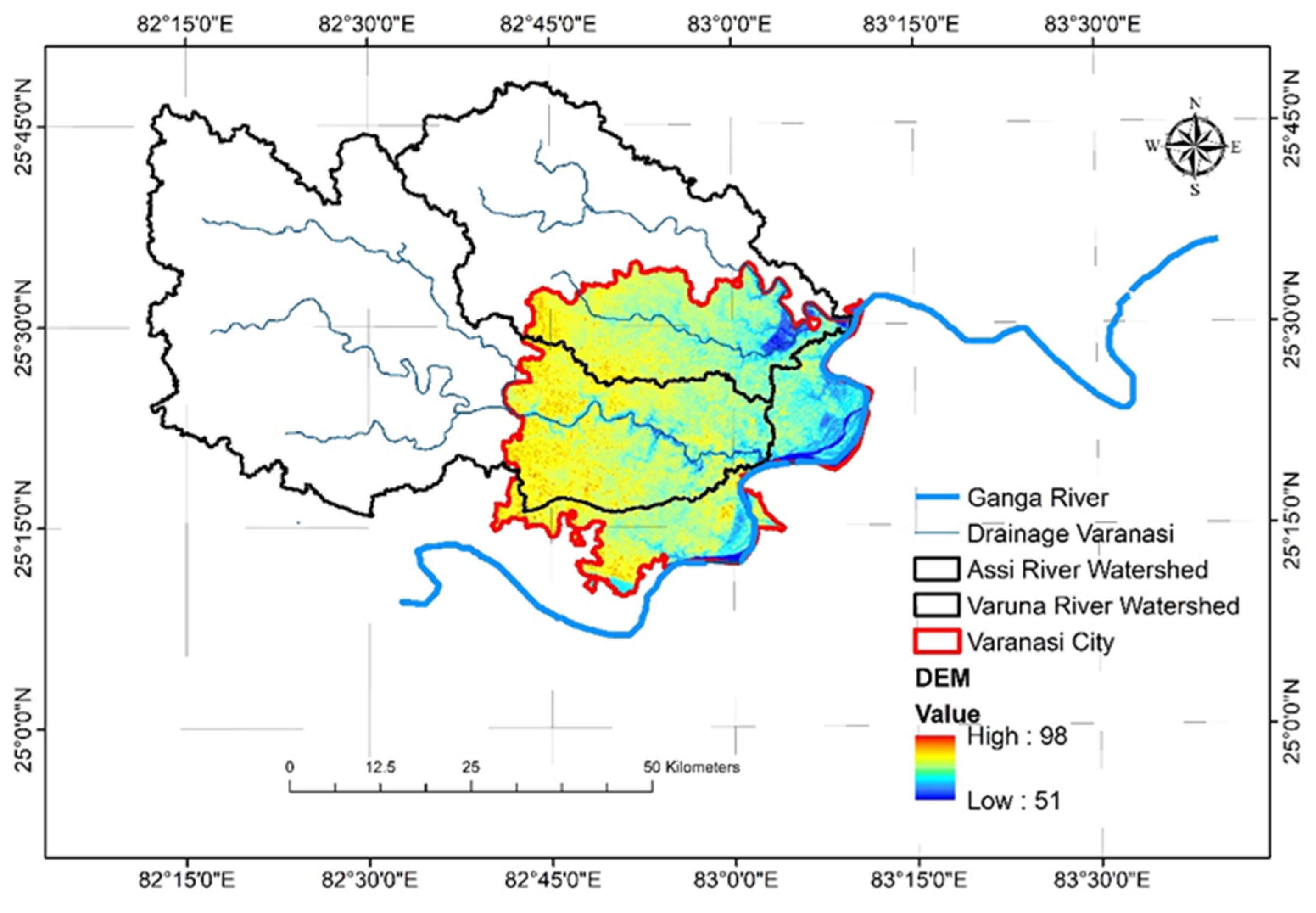
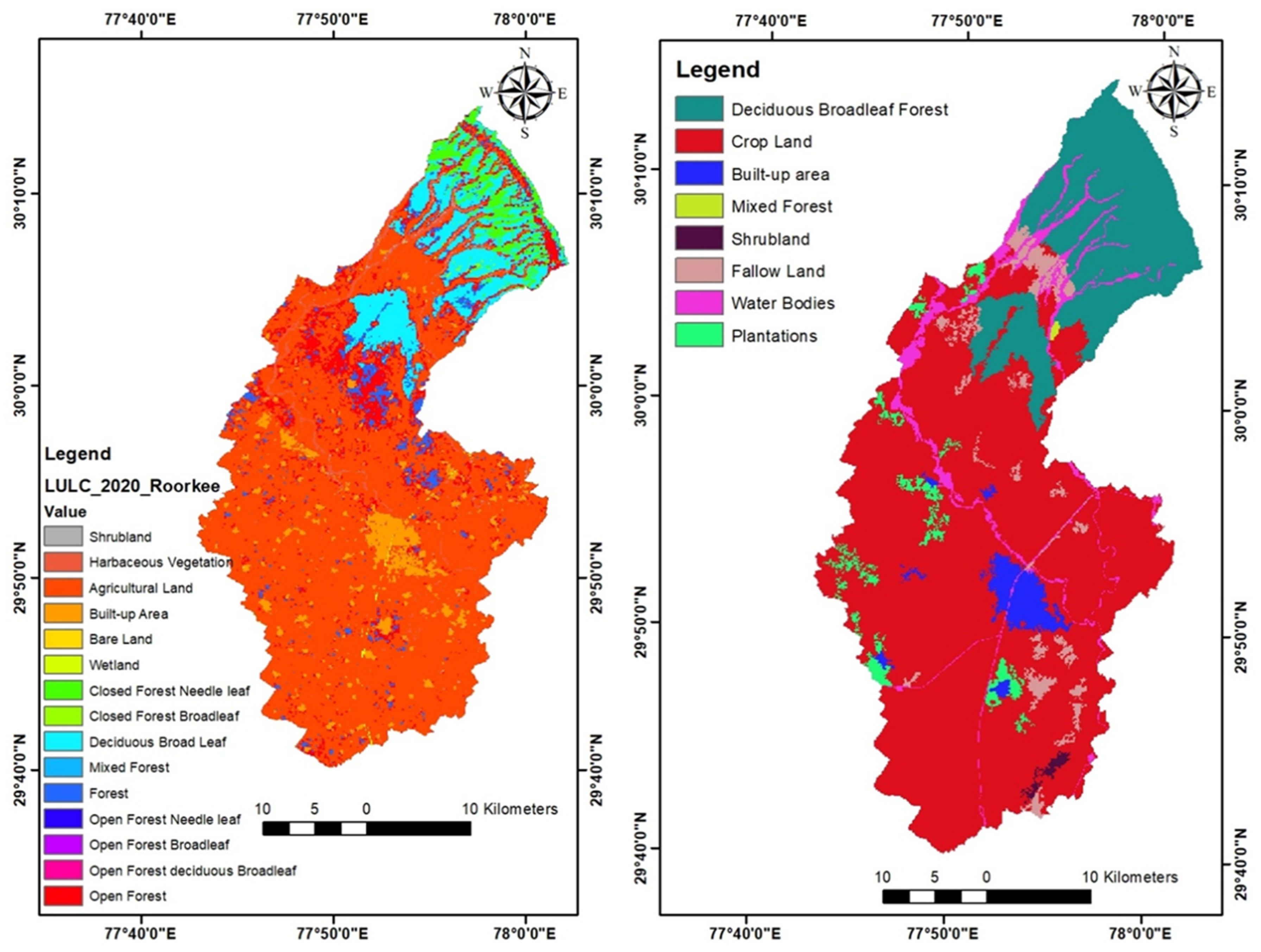



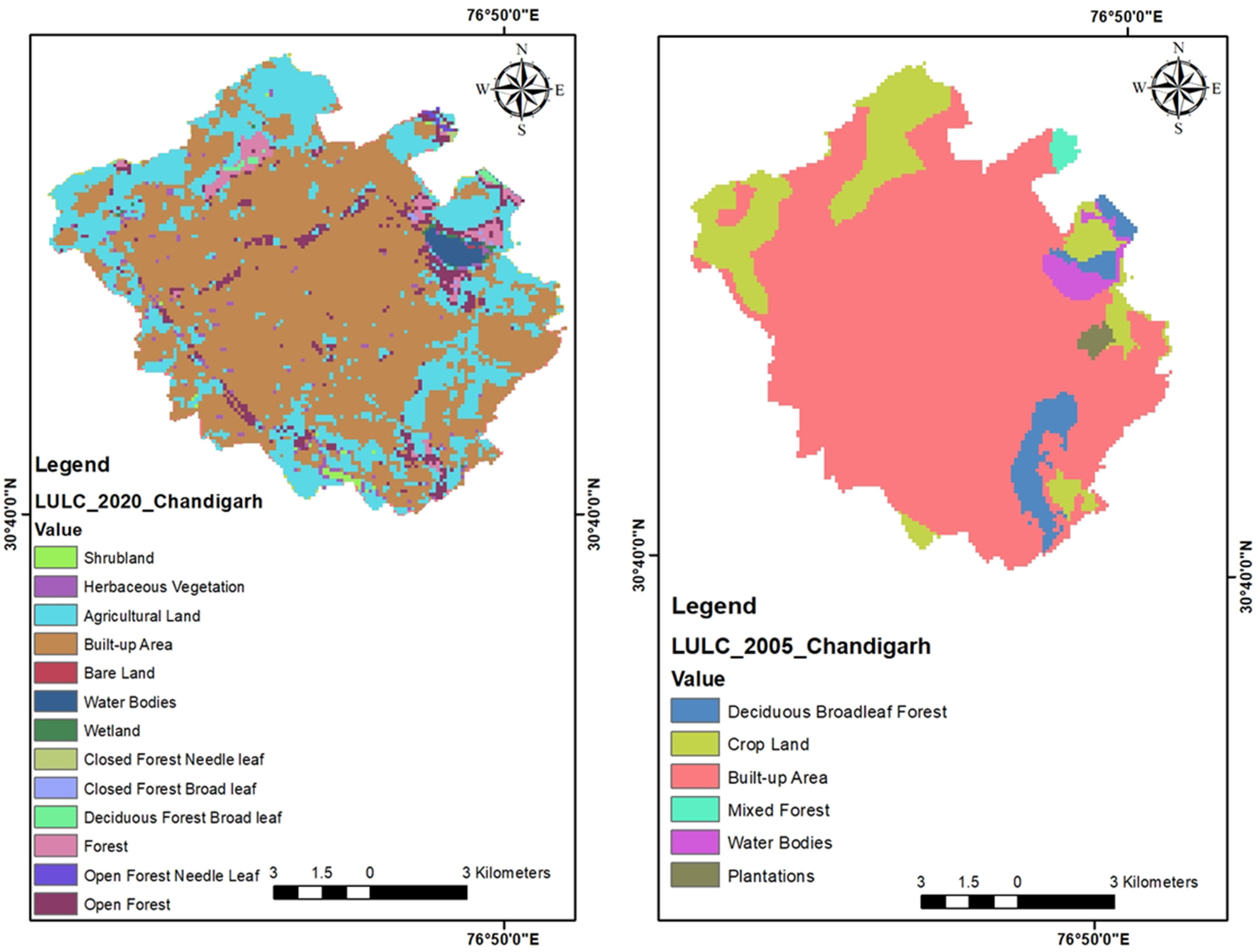
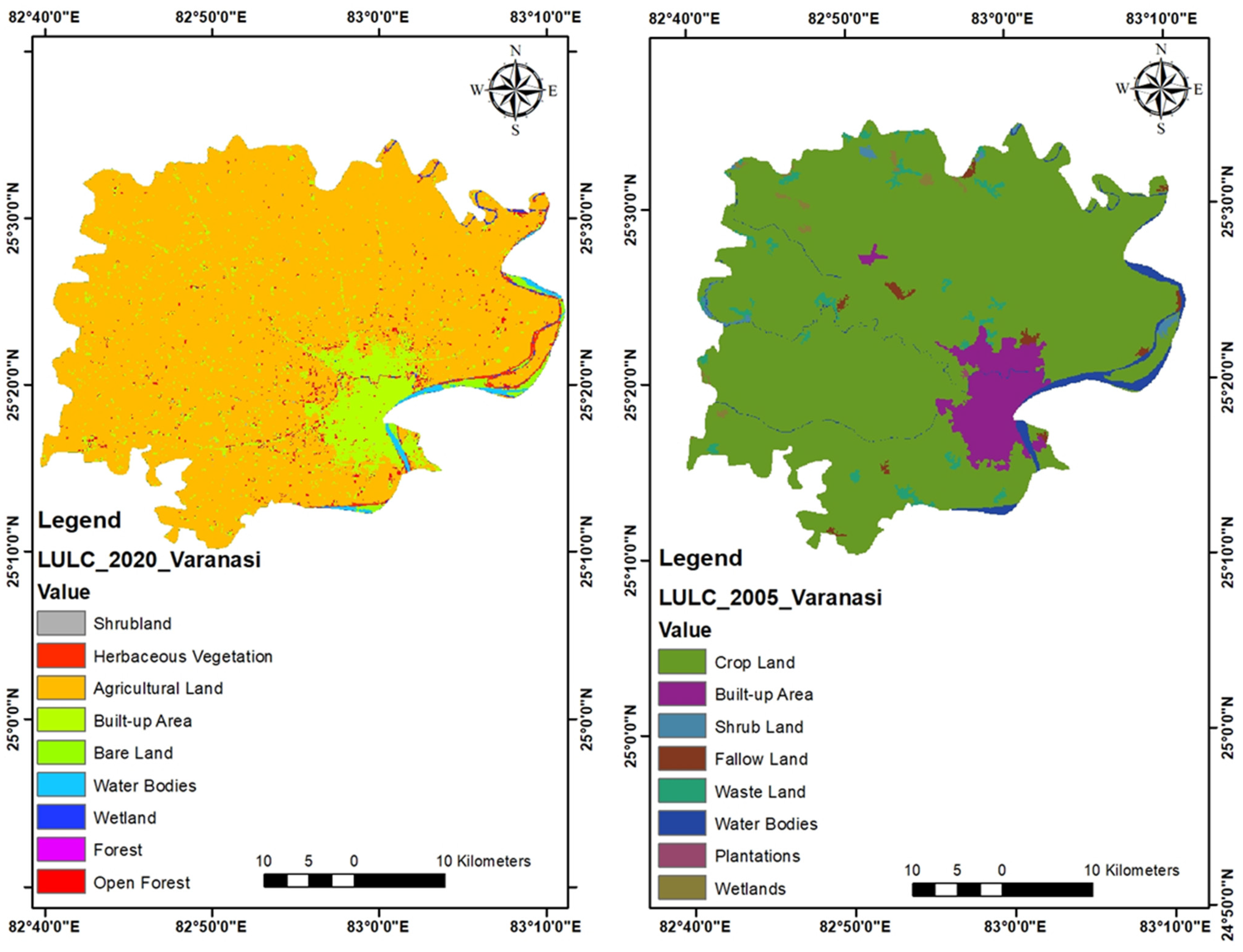
| Sr. No. | Indicator | Ideal Condition/Minimum Desirable Condition | Definition | Status (Included/Excluded with Reason for Exclusion) |
|---|---|---|---|---|
| 1. | Drainage Cleaning Index | 1.0/0.67 | Important parameter as regards routine operation and maintenance/cleaning of drains. | Excluded. Complexity/non availability of data; More focus on management rather than technical status assessment |
| 2. | Water Logging Index | 0 | Areas inundated for four hours or more and having a water depth more than 6 in are considered as affected by water logging. | Included |
| 3. | Water Body Vulnerability Index | 1.0/0.6 | Ratio of total area under water bodies encroached (present date) to the total area under water bodies (on datum date). | Included |
| 4. | Complaint Redressal Index | 1.0/0.9 | Ratio of drainage-related complaints addressed satisfactorily to the total number of drainage-related complaints. | Excluded. Complexity/non availability of data; More focus on management rather than technical status assessment |
| 5. | Drainage Coverage (Construct) Index | 1.0/0.7 | Ratio of the length of existing constructed drains to the length of total constructed drains required for an area. | Included |
| 6. | Rain Water Harvesting/Artificial Ground Water Recharge Index | 0.3 | Ratio of the rainwater volume stored/harvested to the ratio of the measured rainfall volume. | Excluded. Non availability of data/information |
| 7. | Sewage Mixing Index | 0 | Ratio of the volume of sewage flows entering the storm water drainage system to the total volume of flows in the storm water system. | Excluded. Non availability of data/information |
| 8. | Water Bodies Rejuvenation Index | 1.0/0.8 | Ratio of total area under water bodies planned for rejuvenation to the total area of water bodies, including those encroached. | Included |
| 9. | System Robustness Index | <1 | Ratio of rate of incoming storm flow to rate of pumping. | Excluded. Non availability of data/information |
| 10. | Natural Drainage System Index | 1.0/0.7 | Ratio of natural drainage systems up and running to the total natural drainage systems (as existing on a predetermined date). | Included |
| 11. | Area Vulnerability Index | 0 | Ratio of total flood-prone area (present date) to the total city area (on datum date). | Included |
| 12. | People Vulnerability Index | 0 | Number of people affected in vulnerable area with or without drainage divided by total number of people staying in the vulnerable area (with or without drainage). | Included |
| 13. | Flood Moderation Index | 1.0/0.7 | Ratio of area not flooded due to moderation to the area that would have been flooded without moderation. | Included |
| 14. | Permeability Index | 0.3/0.7 | Percentage of the catchment that is impervious. | Included |
| 15. | Master Plan Index | 1.0/0.6 | The basic assumption is that each city has a basic master drainage plan, and where none exists, the master plan would be formulated and the indices would also complement the formulation of the drainage master plan. | Excluded. Non availability of data/information |
| 16. | Tidal Index | <1.0 | Ratio of tidal level for which the present protection is adequate to the maximum tidal level observed for that area/city. | Excluded. Non availability of data/information; Lack of relevance for several cities |
| 17. | Rainfall Intensity Index | Variable | Ratio of the observed rainfall intensity to the rainfall intensity that causes flooding in that particular area. | Included |
| 18. | Preparedness Index/Early Warning Index | 1.0 | Ratio of lead time to the flow time at a certain point. | Excluded. Non availability of data/information |
| 19. | Stormwater Discharge Quality Index | 1.0 | Ratio of the measured value of Total Suspended Solids (TSS)/Bio-chemical Oxygen Demand (BOD) of the storm drain water to the prescribed limits of TSS/BOD. | Included |
| 20. | Climate Change Stress Index | 1.2 | Ratio of the projected rainfall intensity for a city to the present rainfall intensity being used for design for that city. | Excluded. Complexity/difficulty of enumeration; Non-availability of data |
| (a) Rainfall intensity–duration–frequency analysis for Roorkee | ||||||
| Return Period | Intensity (mm/h) | |||||
| 15 min | 30 min | 45 min | 60 min | 120 min | 180 min | |
| 5 years | 116 | 95 | 81 | 71 | 45 | 34 |
| 10 years | 133 | 109 | 94 | 83 | 53 | 39 |
| 25 years | 154 | 127 | 110 | 98 | 63 | 47 |
| 50 years | 169 | 140 | 122 | 109 | 70 | 52 |
| 100 years | 185 | 154 | 133 | 120 | 77 | 57 |
| (b) Rainfall intensity–duration–frequency analysis for Delhi | ||||||
| Return Period | Intensity (mm/h) | |||||
| 15 min | 30 min | 45 min | 60 min | 120 min | 180 min | |
| 5 years | 111 | 85 | 73 | 63 | 47 | 31 |
| 10 years | 118 | 97 | 79 | 72 | 51 | 36 |
| 25 years | 152 | 112 | 101 | 91 | 62 | 44 |
| 50 years | 169 | 126 | 107 | 95 | 69 | 48 |
| 100 years | 188 | 151 | 129 | 106 | 75 | 54 |
| (c) Rainfall intensity–duration–frequency analysis for Mumbai | ||||||
| Return Period | Intensity (mm/h) | |||||
| 15 min | 30 min | 45 min | 60 min | 120 min | 180 min | |
| 5 years | 190 | 111 | 101 | 91 | 49 | 45 |
| 10 years | 216 | 149 | 125 | 101 | 59 | 49 |
| 25 years | 294 | 202 | 176 | 142 | 100 | 90 |
| 50 years | 381 | 251 | 196 | 169 | 113 | 98 |
| 100 years | 485 | 289 | 219 | 195 | 122 | 104 |
| (d) Rainfall intensity–duration–frequency analysis for Chennai | ||||||
| Return Period | Intensity (mm/h) | |||||
| 15 min | 30 min | 45 min | 60 min | 120 min | 180 min | |
| 5 years | 163 | 102 | 81 | 51 | 48 | 38 |
| 10 years | 208 | 132 | 99 | 68 | 50 | 42 |
| 25 years | 252 | 163 | 137 | 102 | 62 | 53 |
| 50 years | 309 | 192 | 151 | 126 | 74 | 63 |
| 100 years | 382 | 231 | 168 | 157 | 98 | 80 |
| (e) Rainfall intensity–duration–frequency analysis for Chandigarh | ||||||
| Return Period | Intensity (mm/h) | |||||
| 15 min | 30 min | 45 min | 60 min | 120 min | 180 min | |
| 5 years | 117 | 91 | 78 | 69 | 44 | 33 |
| 10 years | 119 | 102 | 87 | 79 | 52 | 37 |
| 25 years | 150 | 118 | 106 | 95 | 63 | 46 |
| 50 years | 171 | 133 | 114 | 102 | 71 | 51 |
| 100 years | 190 | 153 | 131 | 117 | 78 | 55 |
| (f) Rainfall intensity–duration–frequency analysis for Varanasi | ||||||
| Return Period | Intensity (mm/h) | |||||
| 15 min | 30 min | 45 min | 60 min | 120 min | 180 min | |
| 5 years | 121 | 75 | 66 | 54 | 47 | 43 |
| 10 years | 129 | 95 | 71 | 59 | 49 | 45 |
| 25 years | 165 | 120 | 84 | 72 | 60 | 54 |
| 50 years | 182 | 135 | 102 | 80 | 65 | 58 |
| 100 years | 221 | 152 | 126 | 98 | 69 | 61 |
| Sr. No. | Cities | NDSI | DCI | PI | WBRI | WLI | AVI | WBVI | PVI | SWDQI | FMI | RII |
|---|---|---|---|---|---|---|---|---|---|---|---|---|
| Ideal/Minimum Desirable Condition | 1.0/0.7 | 1/0.7 | 0.3/0.7 | 1.0/0.8 | 0 | 0 | 1.0/0.6 | 0 | 1 | 1/0.7 | Variable | |
| 1. | Delhi | 0.58 | 0.65 | 0.72 | 0.54 | 0.32 | 0.36 | 0.56 | 0.54 | 0.49 | 0.45 | 0.70 |
| 2. | Mumbai | 0.52 | 0.69 | 0.74 | 0.56 | 0.36 | 0.34 | 0.41 | 0.57 | 0.47 | 0.49 | 0.83 |
| 3. | Chennai | 0.55 | 0.66 | 0.79 | 0.49 | 0.29 | 0.23 | 0.53 | 0.46 | 0.42 | 0.51 | 0.75 |
| 4. | Chandigarh | 0.86 | 0.76 | 0.43 | 0.82 | 0.12 | 0.1 | 0.82 | 0.1 | 0.56 | 0.84 | 0.64 |
| 5. | Varanasi | 0.72 | 0.61 | 0.65 | 0.42 | 0.27 | 0.24 | 0.43 | 0.52 | 0.38 | 0.52 | 0.69 |
| 6. | Roorkee | 0.68 | 0.69 | 0.52 | 0.68 | 0.19 | 0.28 | 0.49 | 0.39 | 0.31 | 0.71 | 0.65 |
| Tier I | Tier II | ||||||||
|---|---|---|---|---|---|---|---|---|---|
| Delhi | Mumbai | Chennai | Chandigarh | Varanasi | Roorkee | ||||
| Indicators | Class | Sustainability Class Ranges and Ratings | Sustainability Class Ratings | Weight % | Weight % | Weight % | Weight % | Weight % | Weight % |
| Natural Drainage System Index | 0.8–1 | Very High | 5 | 11 | 9 | 9 | 15 | 18 | 12 |
| 0.6–0.79 | High | 4 | |||||||
| 0.4–0.59 | Moderate | 3 | |||||||
| 0.2–0.39 | Low | 2 | |||||||
| 0–0.19 | Very low | 1 | |||||||
| Drainage Coverage Index | 0.8–1 | Very High | 5 | 9 | 8 | 9 | 17 | 11 | 10 |
| 0.6–0.79 | High | 4 | |||||||
| 0.4–0.59 | Moderate | 3 | |||||||
| 0.2–0.39 | Low | 2 | |||||||
| 0–0.19 | Very low | 1 | |||||||
| Permeability Index | 0–0.19 | Very High | 5 | 9 | 7 | 8 | 11 | 10 | 12 |
| 0.2–0.39 | High | 4 | |||||||
| 0.4–0.59 | Moderate | 3 | |||||||
| 0.6–0.79 | Low | 2 | |||||||
| 0.8–1 | Very low | 1 | |||||||
| Water Body Rejuvenation Index | 0.8–1 | Very High | 5 | 7 | 11 | 11 | 13 | 7 | 7 |
| 0.6–0.79 | High | 4 | |||||||
| 0.4–0.59 | Moderate | 3 | |||||||
| 0.2–0.39 | Low | 2 | |||||||
| 0–0.19 | Very low | 1 | |||||||
| Water Logging Index | 0–0.19 | Very High | 5 | 12 | 11 | 10 | 5 | 11 | 11 |
| 0.2–0.39 | High | 4 | |||||||
| 0.4–0.59 | Moderate | 3 | |||||||
| 0.6–0.79 | Low | 2 | |||||||
| 0.8–1 | Very low | 1 | |||||||
| Area Vulnerability Index | 0–0.19 | Very High | 5 | 9 | 9 | 9 | 1 | 10 | 7 |
| 0.2–0.39 | High | 4 | |||||||
| 0.4–0.59 | Moderate | 3 | |||||||
| 0.6-0.79 | Low | 2 | |||||||
| 0.8–1 | Very low | 1 | |||||||
| People Vulnerability Index | 0–0.19 | Very High | 5 | 9 | 9 | 10 | 1 | 8 | 8 |
| 0.2–0.39 | High | 4 | |||||||
| 0.4–0.59 | Moderate | 3 | |||||||
| 0.6–0.79 | Low | 2 | |||||||
| 0.8–1 | Very low | 1 | |||||||
| Stormwater Discharge Quality Index | 0.8–1 | Very High | 5 | 6 | 7 | 6 | 8 | 7 | 6 |
| 0.6–0.79 | High | 4 | |||||||
| 0.4–0.59 | Moderate | 3 | |||||||
| 0.2–0.39 | Low | 2 | |||||||
| 0–0.19 | Very low | 1 | |||||||
| Rainfall Intensity Index | 0.8–1 | Very High | 5 | 10 | 9 | 8 | 12 | 10 | 19 |
| 0.6–0.79 | High | 4 | |||||||
| 0.4–0.59 | Moderate | 3 | |||||||
| 0.2–0.39 | Low | 2 | |||||||
| 0–0.19 | Very low | 1 | |||||||
| Water Body Vulnerability Index | 0.8–1 | Very High | 5 | 8 | 9 | 10 | 12 | 9 | 10 |
| 0.6–0.79 | High | 4 | |||||||
| 0.4–0.59 | Moderate | 3 | |||||||
| 0.2–0.39 | Low | 2 | |||||||
| 0–0.19 | Very low | 1 | |||||||
| Flood Moderation Index | 0.8–1 | Very High | 5 | 10 | 11 | 10 | 5 | 9 | 8 |
| 0.6–0.79 | High | 4 | |||||||
| 0.4–0.59 | Moderate | 3 | |||||||
| 0.2–0.39 | Low | 2 | |||||||
| 0–0.19 | Very low | 1 | |||||||
| Total | 100 | 100 | 100 | 100 | 100 | 100 | |||
| Sr. No. | Delhi | Mumbai | Chennai | Chandigarh | Varanasi | Roorkee | |||||||||||||
|---|---|---|---|---|---|---|---|---|---|---|---|---|---|---|---|---|---|---|---|
| Indices | Ii | Wi | Ii Wi | Ii | Wi | Ii Wi | Ii | Wi | Ii Wi | Ii | Wi | Ii Wi | Ii | Wi | Ii Wi | Ii | Wi | Ii Wi | |
| 1 | NDSI | 0.58 | 0.11 | 0.064 | 0.52 | 0.09 | 0.047 | 0.55 | 0.09 | 0.05 | 0.86 | 0.15 | 0.129 | 0.72 | 0.08 | 0.058 | 0.68 | 0.12 | 0.082 |
| 2 | DCI | 0.65 | 0.09 | 0.059 | 0.69 | 0.08 | 0.055 | 0.66 | 0.09 | 0.059 | 0.26 | 0.17 | 0.044 | 0.61 | 0.11 | 0.067 | 0.37 | 0.1 | 0.037 |
| 3 | PI | 0.72 | 0.09 | 0.065 | 0.74 | 0.07 | 0.052 | 0.79 | 0.08 | 0.063 | 0.53 | 0.11 | 0.057 | 0.65 | 0.1 | 0.065 | 0.52 | 0.12 | 0.062 |
| 4 | WBRI | 0.54 | 0.07 | 0.038 | 0.56 | 0.11 | 0.062 | 0.49 | 0.11 | 0.054 | 0.82 | 0.13 | 0.107 | 0.42 | 0.07 | 0.029 | 0.68 | 0.07 | 0.048 |
| 5 | WLI | 0.32 | 0.12 | 0.038 | 0.36 | 0.11 | 0.040 | 0.29 | 0.1 | 0.09 | 0.32 | 0.05 | 0.076 | 0.27 | 0.11 | 0.030 | 0.19 | 0.11 | 0.021 |
| 6 | AVI | 0.36 | 0.09 | 0.032 | 0.34 | 0.09 | 0.031 | 0.23 | 0.09 | 0.021 | 0.58 | 0.01 | 0.058 | 0.24 | 0.1 | 0.024 | 0.28 | 0.07 | 0.020 |
| 7 | WBVI | 0.56 | 0.09 | 0.050 | 0.41 | 0.09 | 0.037 | 0.53 | 0.1 | 0.053 | 0.82 | 0.01 | 0.028 | 0.43 | 0.08 | 0.034 | 0.49 | 0.08 | 0.039 |
| 8 | PVI | 0.54 | 0.06 | 0.032 | 0.57 | 0.07 | 0.040 | 0.46 | 0.06 | 0.028 | 0.6 | 0.08 | 0.048 | 0.52 | 0.07 | 0.036 | 0.39 | 0.06 | 0.023 |
| 9 | SWDQI | 0.49 | 0.1 | 0.049 | 0.47 | 0.09 | 0.042 | 0.42 | 0.08 | 0.033 | 0.56 | 0.12 | 0.067 | 0.38 | 0.1 | 0.038 | 0.31 | 0.09 | 0.028 |
| 10 | FMI | 0.45 | 0.08 | 0.036 | 0.49 | 0.09 | 0.044 | 0.51 | 0.1 | 0.051 | 0.84 | 0.12 | 0.101 | 0.52 | 0.09 | 0.047 | 0.71 | 0.1 | 0.071 |
| 11 | RII | 0.7 | 0.1 | 0.07 | 0.83 | 0.11 | 0.091 | 0.75 | 0.1 | 0.075 | 0.74 | 0.05 | 0.042 | 0.69 | 0.09 | 0.062 | 0.65 | 0.08 | 0.052 |
| OSSI | Total | 0.534 | 0.540 | 0.516 | 0.761 | 0.491 | 0.483 | ||||||||||||
Disclaimer/Publisher’s Note: The statements, opinions and data contained in all publications are solely those of the individual author(s) and contributor(s) and not of MDPI and/or the editor(s). MDPI and/or the editor(s) disclaim responsibility for any injury to people or property resulting from any ideas, methods, instructions or products referred to in the content. |
© 2023 by the authors. Licensee MDPI, Basel, Switzerland. This article is an open access article distributed under the terms and conditions of the Creative Commons Attribution (CC BY) license (https://creativecommons.org/licenses/by/4.0/).
Share and Cite
Vishwakarma, R.K.; Joshi, H.; Goonetilleke, A. Sustainability Evaluation of the Stormwater Drainage System in Six Indian Cities. Sustainability 2023, 15, 14906. https://doi.org/10.3390/su152014906
Vishwakarma RK, Joshi H, Goonetilleke A. Sustainability Evaluation of the Stormwater Drainage System in Six Indian Cities. Sustainability. 2023; 15(20):14906. https://doi.org/10.3390/su152014906
Chicago/Turabian StyleVishwakarma, Rajesh Kumar, Himanshu Joshi, and Ashantha Goonetilleke. 2023. "Sustainability Evaluation of the Stormwater Drainage System in Six Indian Cities" Sustainability 15, no. 20: 14906. https://doi.org/10.3390/su152014906






